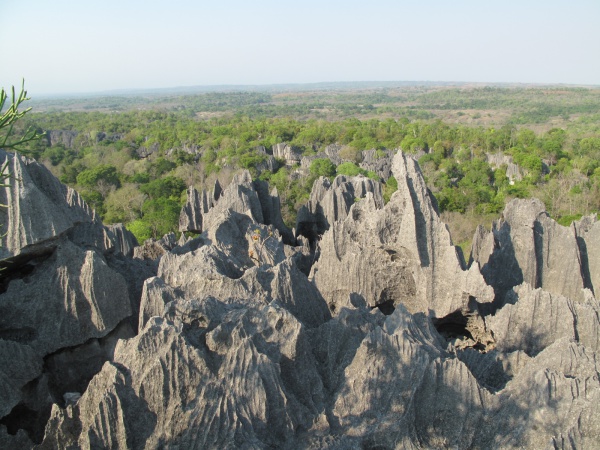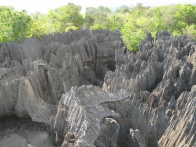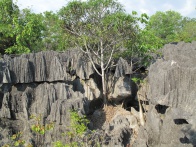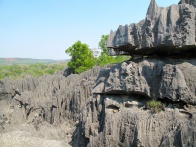Tsingy de Bemaraha National Park
The protected area Tsingy de Bemaraha in the west of Madagascar consists of a national park and integral nature reserve. The site is unique in its biodiversity and exceptional landscape with its Tsingy - which can be translated into "where one can only walk on tiptoe". Bemaraha was the first site in Madagascar to be classified UNESCO World Heritage in 1990, and it also became National Cultural Heritage in 1991. Part of the reserve was changed to a national park status in 1997.

| ||

|

|

|
Bemaraha National Park is located in the Melaky region in the central west Madagascar, about 300km from Antananarivo as the crow flies. The park stretches over an area of 157,710ha, with a length of 100km from north to south and a width of 10 to 40km from east to west. The southern part with an area of 72,340ha enjoys the status of a national park. The northern part, which is managed as an integral natural reserve, covers 85,370ha of land.
The protected area is located on the Bemaraha plateau at an altitude of 150 to 170m, a karst formation bounded to the east by steep cliffs and to the west by gentle slopes. South of the park, there is a formation of pinnacles which access is extremely difficult. In the north rolling hills alternate with limestone formations.
The Bemaraha Park is located north of the Manombolo River. The rivers coming from the plateau have a seasonal or permanent character.
The Bemaraha Massif is a very rugged limestone massif with numerous caves and an impressive canyon carved by the Manambolo River. The western part of the plateau has a very sharp relief, covered in large parts by dense dry forest. That is a true limestone cathedral which offers one of the most spectacular natural landscapes in the world. In the eastern part, the forest is intersected by savannas.
The karstic massif of Bemaraha offers a variety of natural habitats which are many different ecosystems such as dense deciduous forest, bushy xerophytic vegetation on the tsingy (limestone plateau) and sub-humid forest in the valleys or low-laying wet areas between limestone blocks as well as wooded or grassy savanna.
The park is home to lemurs, terrestrial and aquatic birds, bats, amphibians, reptiles, endemic mammals and at least 650 plant species.
The population is predominantly Sakalava. It is an ethnic group that has a conservative nature and protects it by regulations using the fady (ban or taboo).
The park enjoys a dry tropical climate marked by two contrasting seasons: Rainy from November to April and dry between May and October. The opening of the park depends on the accessibility of the dirt road connecting Morondava and Bekopaka, usually from May to November. There are various ways how to get to the park:
By car (4x4)
- Antananarivo - Morondava (600km) and then Morondava - Belo sur Tsiribihina - Bekopaka (south entrance of the park): 200km along a dirt road, 4x4 is recommended for this 8 hours stretch with at least 1 hour by ferry along the Tsiribihina River (100km north of Morondava).
- Antananarivo - Antsalova (700km): 200km paved road to Tsiroanomandidy, between Beravina and Morafeno (crossing of the Bongolava mountains) in very bad condition for over 80km. Thereafter Antsalova - Bekopaka: 100km secondary road, 4 hours by 4x4, accessible from May to November.
By taxi-brousse
- Daily departure from Antananarivo (Fasan'ny Karana station), duration 2 days.
By boat
- From Ankavandra 3 to 4 days sailing with a pirogue along the Manambolo River until Bekopaka. Ankavandra is only accessible by plane.
- From Miandrivazo 3 days by motorised pirogue down the Tsiribihina River until reaching Belo sur Tsiribihina. Thereafter along the road: Belo sur Tsiribihina - Bekopaka (100km, 4 hours by 4x4).
By plane
- Regular flights operated by Air Madagascar and Madagasikara Airways between Antananarivo and Morondava.
View all Tsingy de Bemaraha photos
